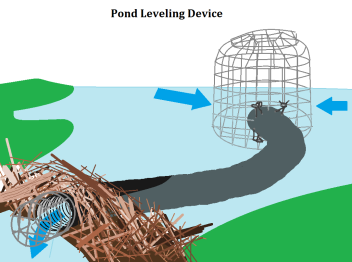Beavers are native to New York State and play an important role in the natural landscape. They are ecosystem engineers – altering water levels by building strong dams using branches and mud; and creating wetland habitat where many plants and animals thrive. However in the wrong place, their dams can cause flooding and property damage. In 2016 a project was developed to minimize beaver impacts by building and installing Beaver Deceivers/ Flood Control Devices. Beaver deceivers stop the flooding caused by beavers, while continuing to allow beavers to live in State Park wetlands and other water bodies.
What is a beaver deceiver?
There are typically two kinds of beaver deceivers; a Trapezoidal-shaped Exclusion Fence (or Trapezoidal Fence for short) and a Pond Leveling Device. Let’s learn the purpose for each:

The Trapezoidal Fence is intended for situations where the beavers’ dam is clogging a culvert and may cause damage to the culvert itself. The fence is placed in front of the culvert, extending out at least 12 feet out from shore with a closed floor so the beaver can’t dig under it. Beavers usually then build their dams along the sides of the fence but not the back – allowing water to flow through the fence into the culvert.

A Pond Leveling Device is made using an existing beaver dam. The dam is dug out (notched) to drop the water body to a desired water level and a corrugated pipe is placed through the dam and then covered back up with dam materials. Both ends are caged off to ensure water flow. The pond leveling device allows the beavers to continue building their dam around the pipe without raising water levels. Thus it prevents flooding of nearby roads and other use areas.
Installation
Materials for this project included 12″ corrugated pipe sections, 6 gauge epoxy coated fencing, copper hog rings to hold the fence together, and cinder blocks to sink structures and pipe.
Here’s a project where we dug out the beaver dam. It was fascinating to see how fast the water level dropped. Beavers are extremely efficient! We also saw about 20 trout swim upstream over the dam to the beaver pond, taking advantage of the new access to the habitat. Naturally, the trout would persist below the dam until the dam fell apart after the beavers moved to a new home – which they do periodically. But in this case, we saw how our deceivers are also able to benefit other native animals.

Finished Product
A pond leveling device installed at the bridge on the School Rd. Trail. The objective of this device was to decrease water levels so the trail would stop flooding. The line on the tree was the water level prior to installation.

State Parks wildlife staff will monitor these beaver deceivers to ensure they continue to functioning properly and that they are still in place. Freezing and thawing during seasonal change may shift the placement of the device. Overall these devices have proven to be highly successful in solving beaver related flooding issues. It is great to solve human wildlife conflict in such a way that both human and wildlife can remain in the same area and neither is pushed out.
Post by Lilly Schelling, State Park Wildlife staff







